Step inside the glamorous homes of Henry Ford
Tour the automotive pioneer's palatial properties
![<p>Courtesy of Seabolt Real Estate / Christie's International Real Estate ; Hartsook / Wikimedia Commons [Public domain]</p>](https://s.yimg.com/ny/api/res/1.2/..XwUMdD15W9TyUnGgCYRQ--/YXBwaWQ9aGlnaGxhbmRlcjt3PTk2MDtoPTYxOQ--/https://media.zenfs.com/en/loveproperty_uk_165/8f066457af831a6988496d65e39e3684)
Courtesy of Seabolt Real Estate / Christie's International Real Estate ; Hartsook / Wikimedia Commons [Public domain]
Henry Ford revolutionised manufacturing and developed the first mass-produced car, ushering in the modern age and growing fabulously wealthy. By the early 1920s he was the world's richest person, building and buying up hundreds of properties during his lifetime ranging from this majestic neoclassical estate to a failed utopia in Brazil and a remarkable collection of 84 historic buildings in Michigan.
Read through to chart the captain of industry's rise from a Michigan farmhouse to the lavish properties paid for by the Model T...
Henry Ford’s childhood home in Dearborn, Michigan

Image from the Collections of The Henry Ford
The first surviving son of William and Mary Ford, Henry was born on 30 July 1863 on the family farm in Springwells Township (now Dearborn), Michigan. His father had come to the US from Ireland to seek a new life, while Henry's mother was born in the Great Lake State to Belgian immigrants.
Henry's childhood home was built two years before his birth. The simple two-storey clapboard farmhouse has five bedrooms, a parlour, a kitchen-living room and more but it was crammed full of people: Henry, his parents, his paternal grandparents, his mother's foster parents and his five siblings.
An early fascination with mechanics

James R. Martin / Shutterstock
Henry may have dropped out of school but he excelled at one thing: tinkering with mechanical objects. The future automaker's fascination with machines intensified in his early teens when he was gifted a pocket watch, which he took apart to figure out its inner workings. Around the same time, he also observed a steam engine in action for the first time.
Just before Henry's 13th birthday, his mother Mary died leaving him bereft. He later restored his childhood home in her honour, replicating exactly how it looked when she passed away in 1876. In spite of or because of his grief, the teenager threw himself into his pastime.
Henry Ford's first Detroit home
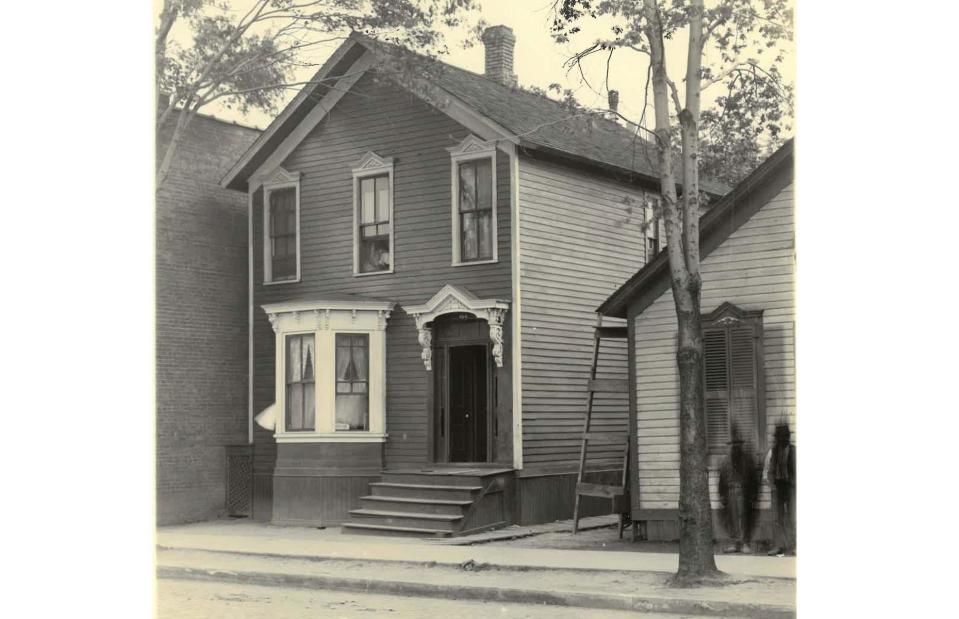
Image from the Collections of The Henry Ford
After becoming a dab hand at repairing watches – the enterprising youngster fixed timepieces for his neighbours and friends – Henry turned to steam engines, building his first prototype at the age of 15. A year later, the go-getting teenager walked eight miles to Detroit and landed an apprenticeship at a machine shop within a shipbuilding firm.
His first home off the farm was this long-demolished house on Detroit's Franklin Street, which belonged to his aunt, Rebecca Ford Flaherty.
Henry Ford returns to the family farm
![<p>Wikimedia Commons [Public domain]</p>](https://s.yimg.com/ny/api/res/1.2/SUCfDm.9Jlrah8m6noWpGQ--/YXBwaWQ9aGlnaGxhbmRlcjt3PTk2MDtoPTYxOQ--/https://media.zenfs.com/en/loveproperty_uk_165/e89fbc2c92a9aa97c41a4c4004c4c87a)
Wikimedia Commons [Public domain]
After completing the apprenticeship, Henry had a stint working on Westinghouse steam engines and discovered the marvels of the internal combustion engine, before returning to his childhood home in 1882. Henry did very little in the way of farming and instead spent most of his time working on his beloved machines.
Still, the future auto tycoon did find time to find love. Here he is in 1888 aged 25. That same year, Henry walked down the aisle with Clara Bryant, who he'd met at a New Year's dance three years prior.
Henry's father presented the newlyweds with a 40-acre (16ha) parcel as a wedding gift. The plot included an old homestead, the duo's first marital home, and plenty of mature trees.
Henry Ford’s marital Square House in modern-day Dearborn, Michigan
![<p>Andrew Jameson / Wikimedia Commons [CC BY-SA 3.0]</p>](https://s.yimg.com/ny/api/res/1.2/RCQkmUQrH3rx0kirfKD4bg--/YXBwaWQ9aGlnaGxhbmRlcjt3PTk2MDtoPTYxOQ--/https://media.zenfs.com/en/loveproperty_uk_165/5a9d6c2a0a2562456e4892beb86554cd)
Andrew Jameson / Wikimedia Commons [CC BY-SA 3.0]
Putting his lumberjack hat on, Henry set up a sawmill on the property and swiftly built this charming home known as the 'Square House', completed in May 1889. Clara was said to be behind the unusual boxy design of the dinky 169-square-foot (15sqm) residence, which has only four rooms: a parlour, sitting room, kitchen and sole bedroom.
In 1891, Henry got his dream job as an engineer for the Edison Illuminating Company in Detroit. The Fords packed their bags and left for the big smoke, but held on to the Square House until 1937. The property was eventually moved six miles west to save it from demolition and is now privately owned.
Edsel Ford's birthplace in Detroit

Image from the Collections of The Henry Ford
The Fords rented an apartment above a laundry on Detroit's John R Street and stayed there until the spring of 1892. They then moved twice before relocating to this house on 570 W Forest Avenue in 1893. It was a memorable year for Henry. The couple's only child Edsel was born in this very house, meanwhile, Henry was promoted to chief engineer.
By this time, the genius innovator had created a commercially viable horseless carriage powered by an internal combustion engine. While he was on call 24 hours a day, Henry's role at the Edison llluminating Company allowed him to work on the project since he had ample time to kill between call-outs. On Christmas Eve of the same year, Henry built his first petrol-fuelled internal combustion engine.
The unassuming birthplace of Ford Motor Company

Image from the Collections of The Henry Ford
At the end of 1893, the Fords decamped to this Victorian rowhome at 58 Bagley Avenue. With the petrol-powered engine in the bag, Henry turned his attention to creating the horseless carriage part.
The auto visionary converted the brick storage shed behind the house into a workshop and got his head down. Success came in 1896 when Henry completed his first car, the Quadricycle. The rudimentary automobile comprised a four-horsepower petrol engine attached to a lightweight metal frame and four bicycle wheels.
Perfecting an iconic design
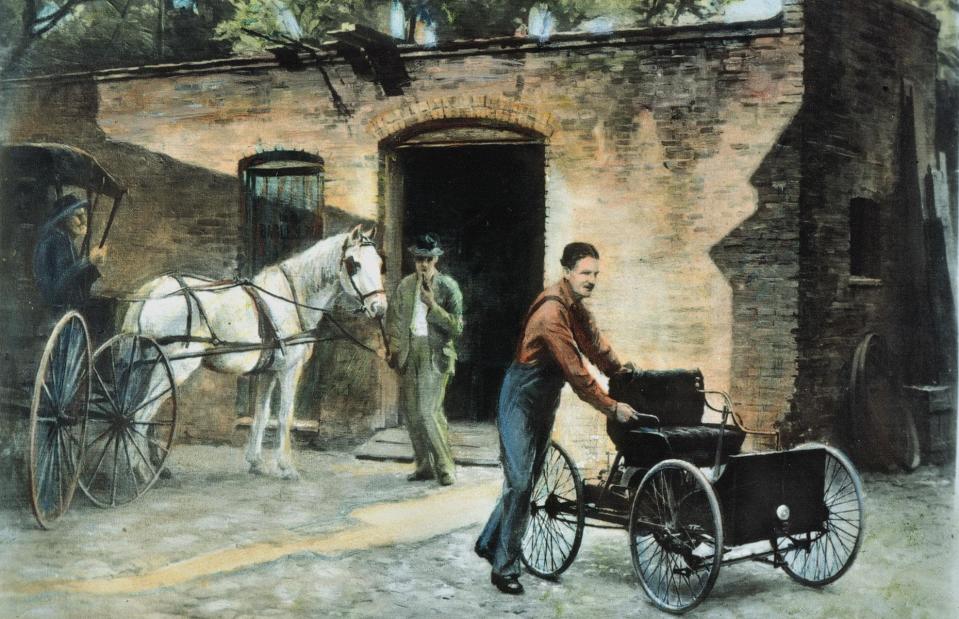
GRANGER - Historical Picture Archive / Alamy
That same year, Henry met the big boss Thomas Edison and struck up a lifelong friendship. The legendary inventor was impressed by the Quadricycle and encouraged Henry to develop it further.
Buoyed on by the support of his powerful and influential boss, Henry hit the workshop and eventually came up with an improved version of the Quadricycle. In 1897, the year the Fords moved out of 58 Bagley Avenue and into another rented property, Henry was awarded his first patent for a carburettor. A testament to his ingenuity, he'd eventually rack up 161 patents in total.
A new, affordable motorcar

paulcannonstudio / Alamy
Henry's workshop at 58 Bagley Avenue was demolished after the Fords left but the structure was later meticulously recreated.
Henry left the Edison Illuminating Company in 1899 to fully pursue his auto dream. After a few failed ventures, he founded the Ford Motor Company in 1903, to launch the first affordable motorcar. Henry reached that goal in 1906 with the release of the Ford Model N. At $500, equivalent to around $17,400 (£137k) today, it undercut the rival Oldsmobile Runabout by a hefty $150. Unsurprisingly, sales were brisk.
Henry Ford's custom mansion in Detroit
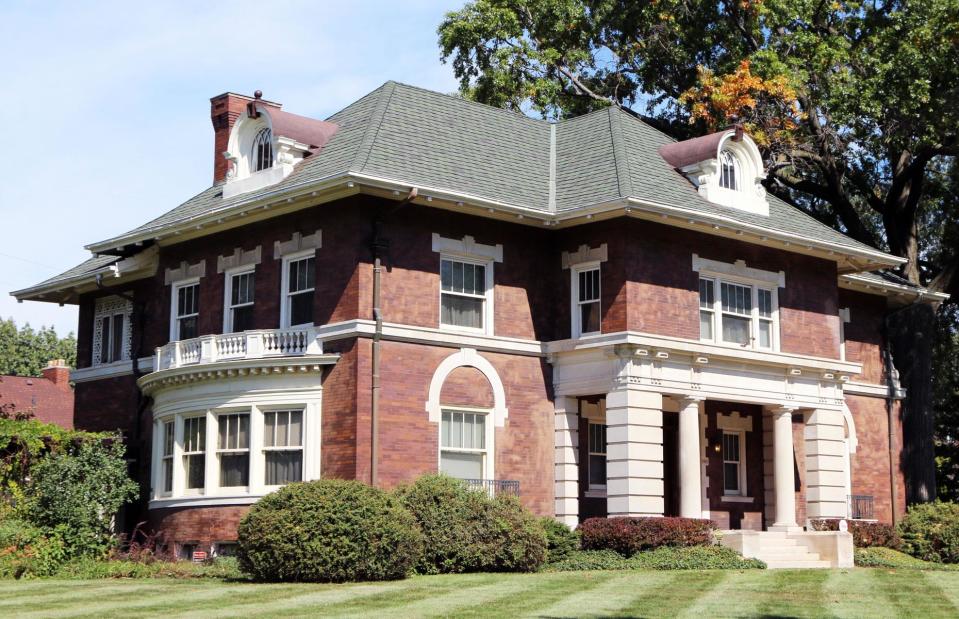
James R. Martin / Shutterstock
With business booming, Henry went up in the world in 1908 when he moved his family into this custom Italian Renaissance-style mansion at 66 Edison Avenue in Detroit (now 140 Edison Street). Amazingly, the couple had rented 11 homes in the city before commissioning one of their own. The four-bedroom property in the upscale Edison-Boston district was designed by leading Detroit architect William Higginbotham and has a wealth of fancy features, including grand Tuscan-style columns.
The Ford Model N sold like hotcakes but it was the vehicle's successor that proved to be the blockbuster hit. The first Model T was shipped on 1 October 1908 and the rest is history. Starting at a reasonable $825, which is roughly $28,000 (£22k) today, Tin Lizzie as the car was nicknamed was remarkably reliable, easy to repair and packed with advanced features that belied its affordable price tag.
Henry Ford's summer cottage in Harbor Beach, Michigan

Image from the Collections of The Henry Ford
Sales of the Model T really took off after 1913 when the Ford Motor Company installed the first moving assembly line for the production of an automobile. It was an astonishing innovation that slashed the time it took to build a car from more than 12 hours to just over an hour and a half. In 1914, the price of the basic vehicle dropped to $440, around $13,800 (£10.9k) today, and more than 200,000 Model Ts were sold, up from just 239 in 1908.
With his personal fortune skyrocketing, Henry splashed out on his first summer cottage in 1914, this rustic property on Lake Huron in Michigan's Thumb region. He went on to own several summer retreats, including an estate on Grosse Ile and a home within the ultra-exclusive Huron Mountain Club in Michigan's Big Bay.
Henry Ford's Fair Lane castle in Dearborn, Michigan

Goddard Archive / Alamy
Henry and Clara had acquired 1,300 acres (526ha) of land in Henry's hometown of Dearborn and embarked on building their dream home. Detroit was becoming too built up and the couple was craving more space and privacy.
Iconic architect Frank Lloyd Wright was tapped to design the property but the commission ultimately went to his protégé, Marion Mahony Griffin, America's first prominent female architect. Mahony Griffin, who was associated with Chicago firm von Holst and Fyfe, designed a Prairie-style residence, however, the Fords later dismissed the firm. Yearning for something more traditional, Pittsburgh architect William Van Tine was hired to rework Mahony Griffin's design. The house was finally completed in early 1916 in an eclectic style combining elements of Prairie design with nods to late English Gothic castles.
Packed with state-of-the-art amenities
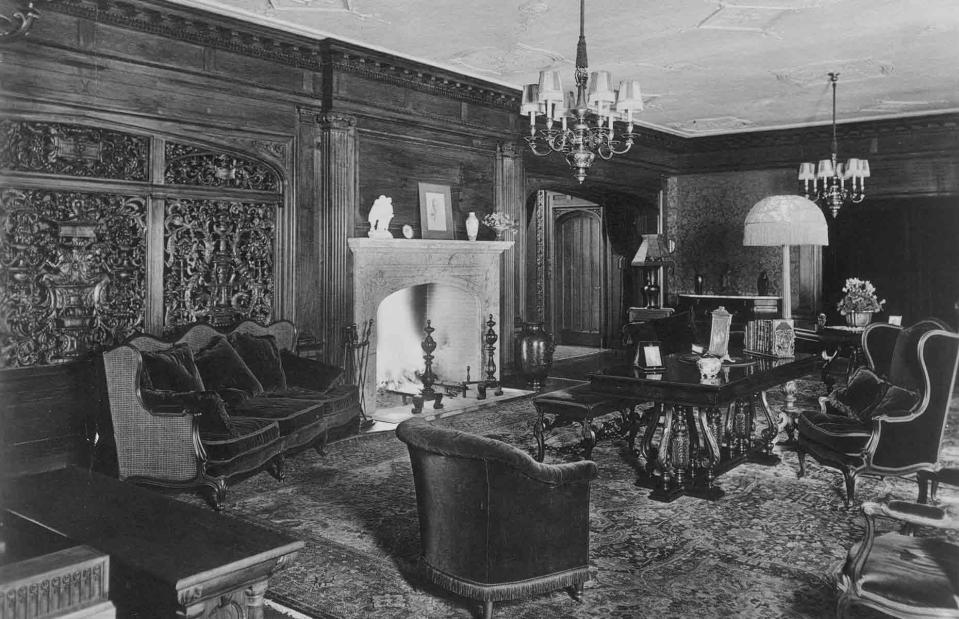
GRANGER - Historical Picture Archive / Alamy Stock Photo
After offloading their Detroit mansion, the Fords made Fair Lane their home. Nestled within beautifully landscaped grounds, the imposing limestone mansion sprawls over 31,000 square feet (2,880sqm) and originally featured a total of 56 rooms, including this English manor-style wood-panelled living room, seven bedrooms and 15 bathrooms.
Loaded with wow-factor amenities, the property was kitted out with an indoor swimming pool, a bowling alley and a tunnel leading to a futuristic powerhouse. Built on the advice of Thomas Edison, it was packed with hydroelectric generators and also housed Henry's laboratory.
A beloved lifelong home

Pictorial Parade / Hulton Archive / Getty Images
Fair Lane, which was named after the birthplace of Henry's paternal grandfather in Ireland's County Cork, ended up serving as the couple's principal home for the rest of their lives.
Mr and Mrs Ford are shown here posing for a portrait at the castle in 1943. Henry was aged 80 when the photograph was taken, while Clara was around 77. Henry died four years later and Clara passed away in 1950. Fair Lane was then transferred to the Ford Motor Company and most of the original contents were removed.
Extensive restoration underway
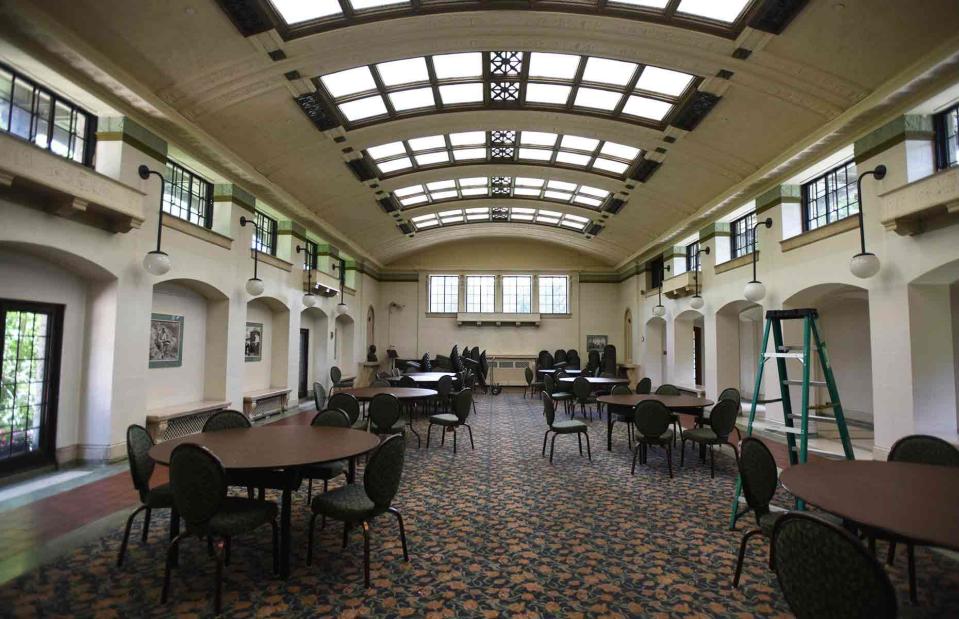
Associated Press / Alamy
Ford donated the property to the University of Michigan in 1957 and it was converted into a museum. Over the years, the main house resembled its original incarnation less and less and the indoor pool was transformed into a restaurant, pictured here.
The museum closed to the public in 2010 and in 2013 a nonprofit led by Henry's great-grandson Edsel II took ownership of the property. In 2019, an independent nonprofit was formed with the aim of replicating the original look and feel of the home. A vast amount of restoration work has since been carried out but the project, which relies on charitable donations, is yet to be completed.
Henry Ford's The Mangoes winter retreat in Fort Myers, Florida
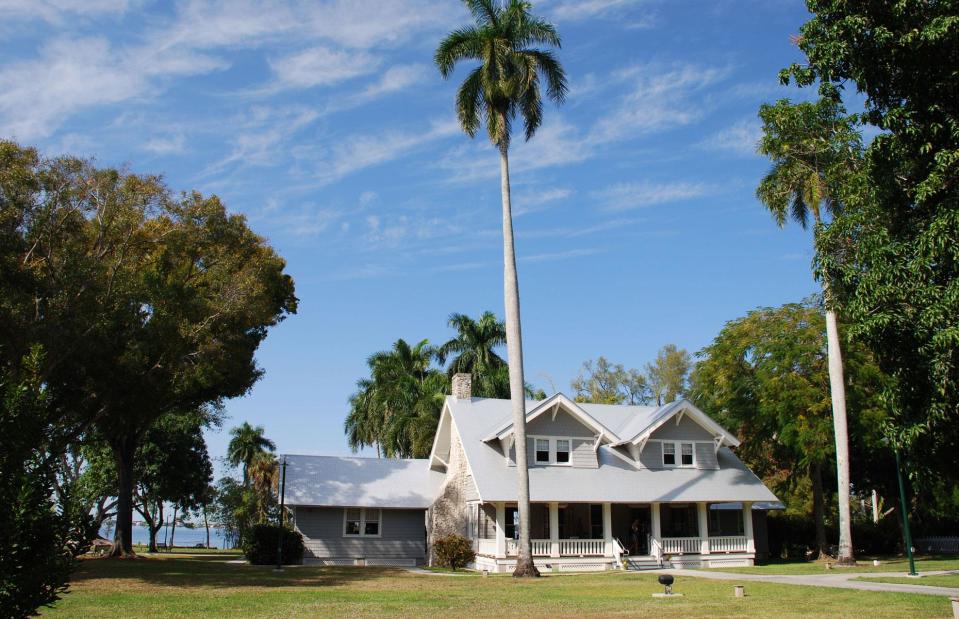
Nancy Tobin / Alamy
Early snowbirds, the Fords made like many mega-rich families of the time and escaped the bitterly cold Michigan winters for balmier climes.
In 1916, the couple bought this two-storey Craftsman bungalow on the banks of the Caloosahatchee River in Florida's Fort Myers. Dubbed The Mangoes on account of the row of mango trees that graced the lushly planted grounds, it was the Ford family's winter escape until 1931.
An informal vacation retreat
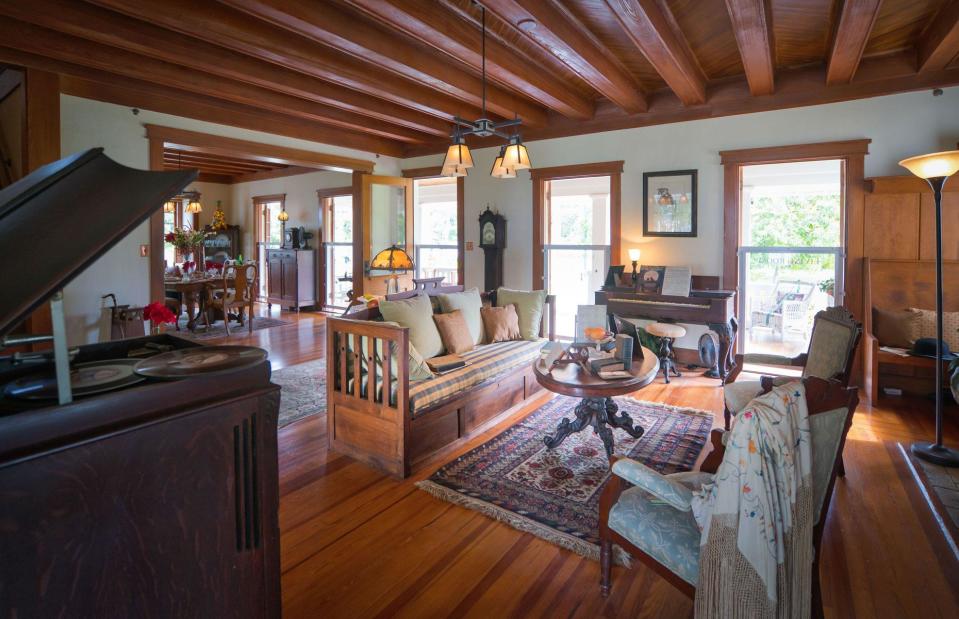
SR Productions / Alamy
In contrast to the stuffy formality of the Fords' castle-like mansion in Dearborn, The Mangoes was decorated in a simple, unpretentious style, eschewing grandeur for home comforts. Clearly this was a place for the Fords to relax and entertain in a more casual way.
Their guests of honour were Henry's mentor and friend Thomas Edison and his wife Mina, who wintered in the house next door. Interestingly, the Fords were inspired to buy The Mangoes after they stayed with the Edisons in 1914.
Thomas Edison's Seminole Lodge winter retreat in Fort Myers, Florida

Richard Ellis / Alamy
The Edisons' estate was called Seminole Lodge. Thomas Edison bought the land in 1885 and went on to build a handsome but similarly unpretentious main house, as well as a guest house, caretaker's house, laboratory and one of America's first residential swimming pools.
The two couples shared a love of bracing outdoor activities and partook in everything from swimming, boating and fishing to bird watching.
An enduring friendship
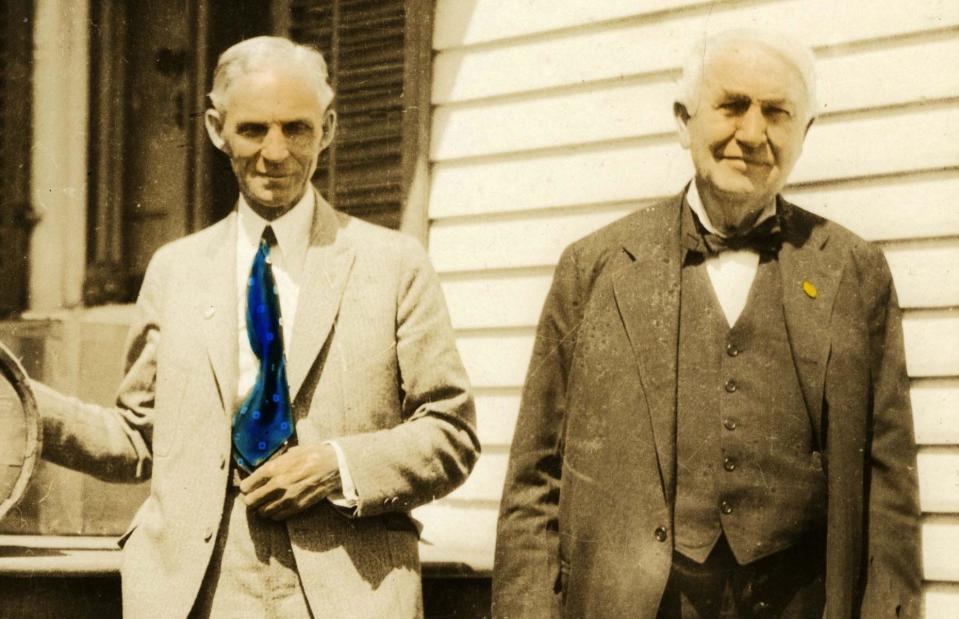
Gina Rodgers / Alamy
Henry always ensured he was in Fort Myers on one very special day of the year, 11 February, which was Thomas Edison's birthday.
When the great inventor died in 1931, the Fords stopped wintering in Fort Myers. The Mangoes was eventually sold in 1945 to a private buyer, while Seminole Lodge was later donated by Mina Edison to the City of Fort Myers and opened as a museum. The Mangoes was later acquired by the city and today the properties operate as the Edison and Ford Winter Estates.
Henry Ford’s Cherry Hill House in Richmond Hill, Georgia

Courtesy of Seabolt Real Estate / Christie's International Real Estate
By 1925, Henry had perfected what came to be known as Fordism: an ultra-efficient manufacturing system producing high-volume, low-cost goods while also paying workers decent wages – Henry has even been credited as creating America's middle class and its consumer society since he gave his employees the means to buy the products they were making.
A staggering 10 million Model Ts had been sold by the mid-1920s and Henry's net worth had swelled to $1.2 billion, the equivalent of $22 billion (£17.3bn) today. With piles of cash to splash, the automotive pioneer expanded his property portfolio in 1925, acquiring this beautiful mansion in Richmond Hill, Georgia and then buying up swathes of land in the surrounding area for agricultural projects.
Grand Colonial-style manse

Andrew Frazier / Courtesy of Seabolt Real Estate / Christie's International Real Estate
Cherry Hill House was constructed in 1874 after the estate's original residence burned to the ground in the Civil War. It was built on the same site as its predecessor by the wealthy Arnold family in a grand Colonial style.
The property was the Fords' primary winter home from 1931 to the late 1930s when their even more lavish custom Georgian Revival mansion was completed just down the road on the larger estate Henry had acquired along the Ogeechee River.
Restored to its former glory
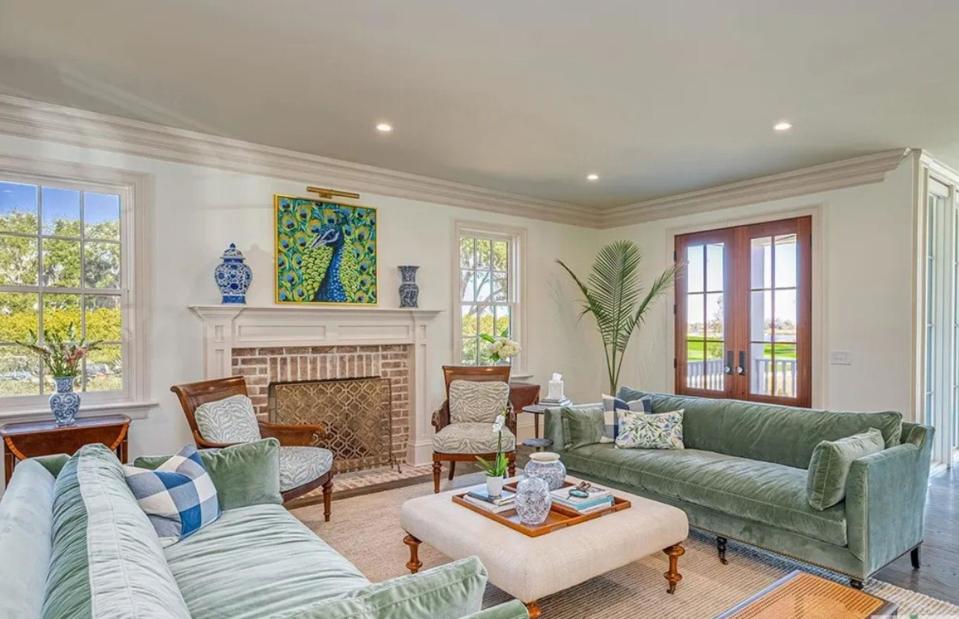
Andrew Frazier / Courtesy of Seabolt Real Estate / Christie's International Real Estate
Henry held on to Cherry Hill House and it was used as a guest house for the new mansion from 1937 onwards. The property was under Ford ownership until 1951.
Over the subsequent decades, the mansion passed through several private owners and was split into a duplex. The current owners bought the property in 2022 for under $1.1 million (£862k) and have since restored the structure to a single-family home, carried out an extensive renovation and added a four-bay garage. As you can see, the couple was careful to retain the period features and the end result is a sensitive homage to the home's history.
The start of a new chapter

Andrew Frazier / Courtesy of Seabolt Real Estate / Christie's International Real Estate
With an asking price of just under $4.2 million (£3.3m), this stunning historic estate was put on the market with Seabolt Real Estate via Christie's International Real Estate.
Ford was riding high in the late 1920s. The company opened the River Rouge plant, the world's biggest factory, in 1927 and launched the Model T's successor, the Model A, to great acclaim. Henry was preoccupied with controlling every aspect of the manufacturing process, right down to the rubber for the tyres. At the time, the British had a stranglehold on the natural material, which kept prices artificially high, though the monopoly was on the wane. The pioneering carmaker's answer was to create his very own latex-producing model city deep in the Amazon Rainforest in Brazil.
Henry Ford's failed 'utopian' Fordlandia model city in Brazil
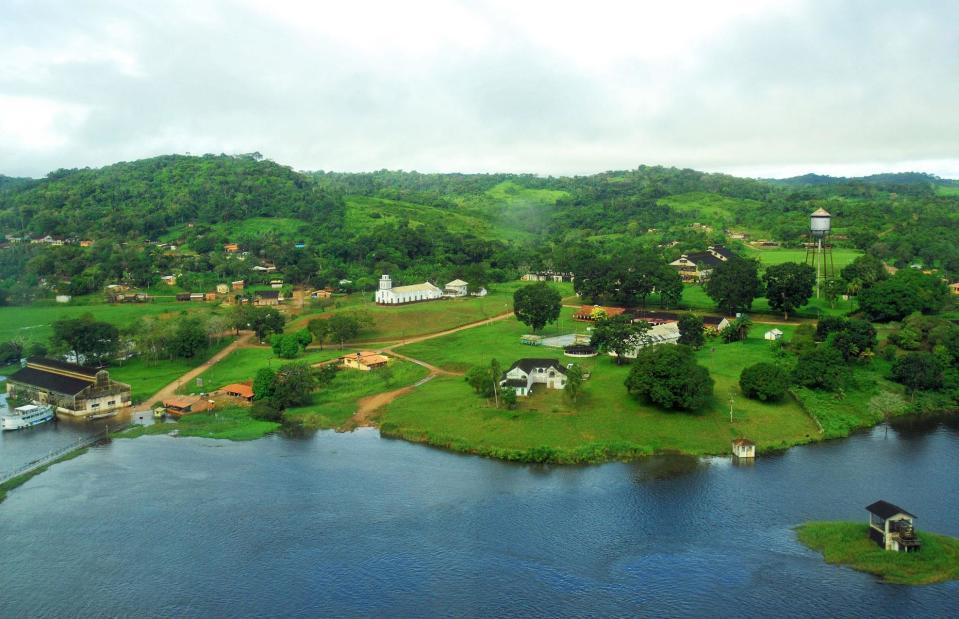
A.PAES / Shutterstock
Henry negotiated a deal with the Brazilian government for over 5,000 square miles (13,000sqkm) of land along the Tapajós River in the north of the country and his model jungle city was established in 1928. Henry had high hopes for the city, which was named Fordlandia in his honour. A showcase for Fordism and Henry's social engineering interests, it was essentially Henry's idea of the perfect Midwestern settlement transplanted in the Amazon jungle.
A population of 10,000 highly paid workers was projected and the city was laid out on a US-style grid with American-style houses, schools, a hospital, church, library, hotel and leisure amenities such as a swimming pool and golf course, with the chief landmark being a soaring water tower. But the project was plagued with problems from the get-go.
Culture of surveillance
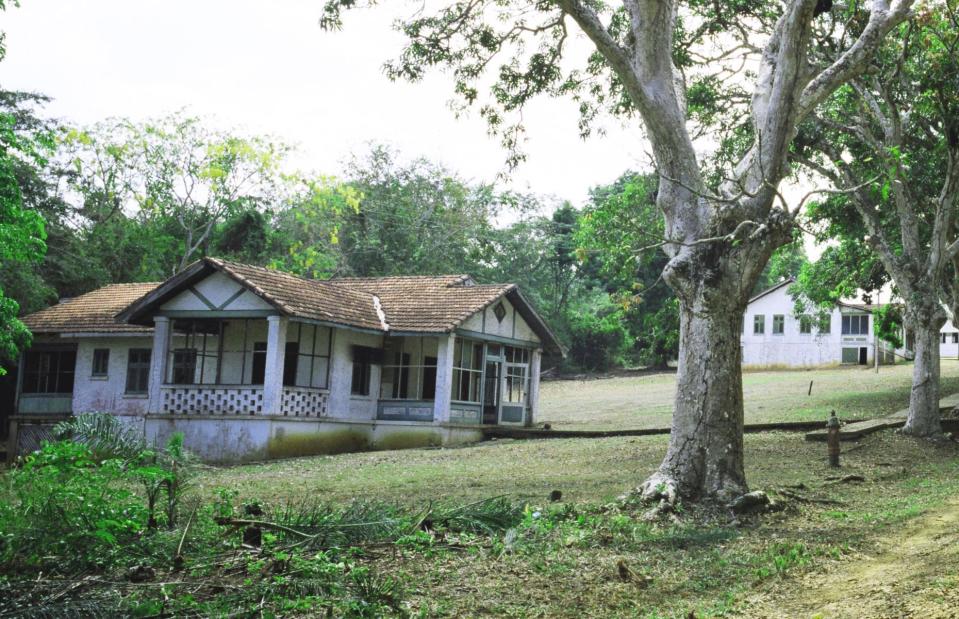
Colin McPherson / Corbis via Getty Images
The city's rubber plantation was planned by Americans with little knowledge of the local ecology. Sown too close together, the rubber trees were decimated by diseases and pests.
As well as wanting to control every aspect of the manufacturing process, Henry reportedly sought to control other aspects of his workers' lives. Established in 1915, the Ford Sociological Department kept tabs on employees' hygiene, moral behaviour, finances and more. This culture of surveillance reached fever pitch in Fordlandia. Henry imposed a long list of rules, including bans on alcohol, tobacco, gambling and even football, according to Greg Grandin's book Fordlandia. Residents of the company town were subject to Henry's odd dietary preferences too and pressured to eat American foods they weren't accustomed to like wholemeal bread, oatmeal and canned peaches.
Contentious housing
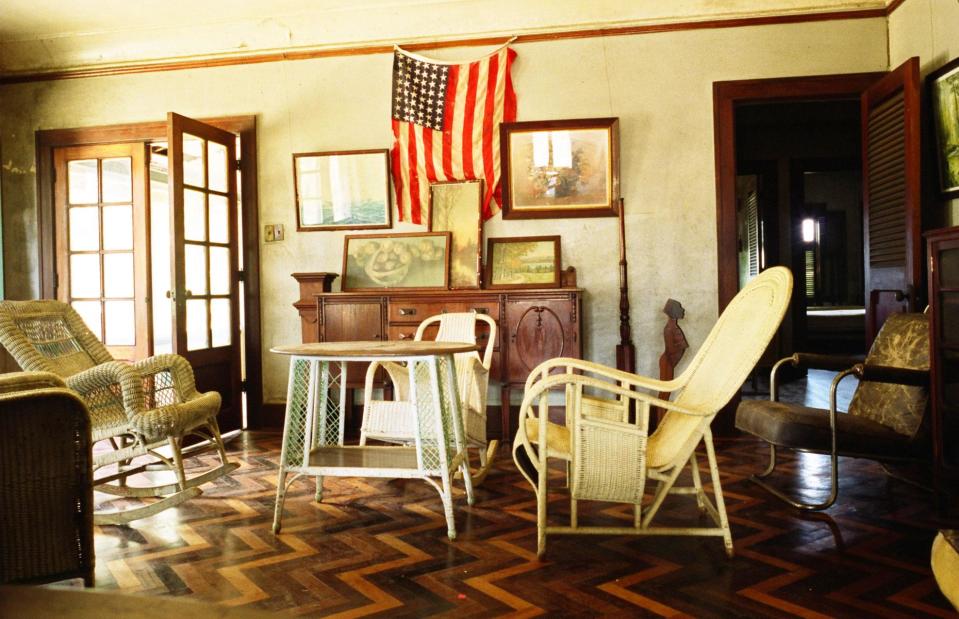
Colin McPherson / Corbis via Getty Images
Ford's rules understandably caused resentment among the local workers despite the generous wages. Another bone of contention was housing. The US managers resided in the 'Vila Americana' mini-suburb in relatively luxurious Cape Cod-style homes with all mod cons (pictured), while the Brazilian employees had to make do with basic bungalows that had no running water, according to Grandin.
Tensions came to a head in 1930 following an argument over the way the food was served in the cafeteria, sparking a riot among workers that damaged parts of the city.
Staggering financial loss
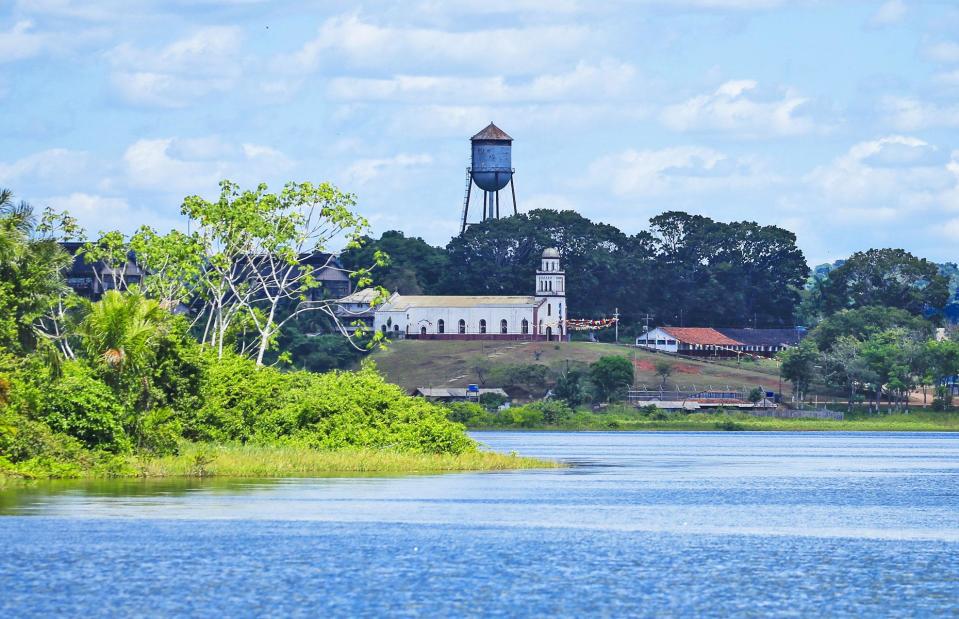
Joel Auerbach / Getty Images
The hiring of a new manager calmed the situation but Fordlandia was doomed. In 1931, a site 60 miles (96km) downriver was chosen for a new plantation and in 1934, Henry's 'utopian' city was abandoned, without so much as an ounce of latex making it into a Ford car. Belterra as the new plantation was called fared better than Fordlandia, but it too was ultimately deemed a failure.
In 1945, Ford sold the land back to the Brazilian government for just $244,200, or $4.3 million (£3.4m) in today's money. It was a fraction of the $20 million that had been invested in the ill-fated project, which equates to some $367 million (£289m) now. More or less vacant for decades, Fordlandia has enjoyed something of a revival in recent years, with many of the houses reclaimed and 2,000 to 3,000 people now call it home.
Greenfield Village in Dearborn, Michigan

Matthew G Eddy / Shutterstock
Henry was obsessed with documenting day-to-day American history and presenting it in a fun, accessible way. In the late 1910s, he came up with the idea of a new kind of indoor-outdoor museum complex and spent more than a decade planning it for a site he'd earmarked in Dearborn.
Initially named the Edison Institute, the complex was dedicated to Henry's close friend Thomas Edison in a spectacular ceremony attended by President Herbert Hoover, Marie Curie, Orville Wright and John D Rockefeller in 1929.
Pioneering outdoor museum
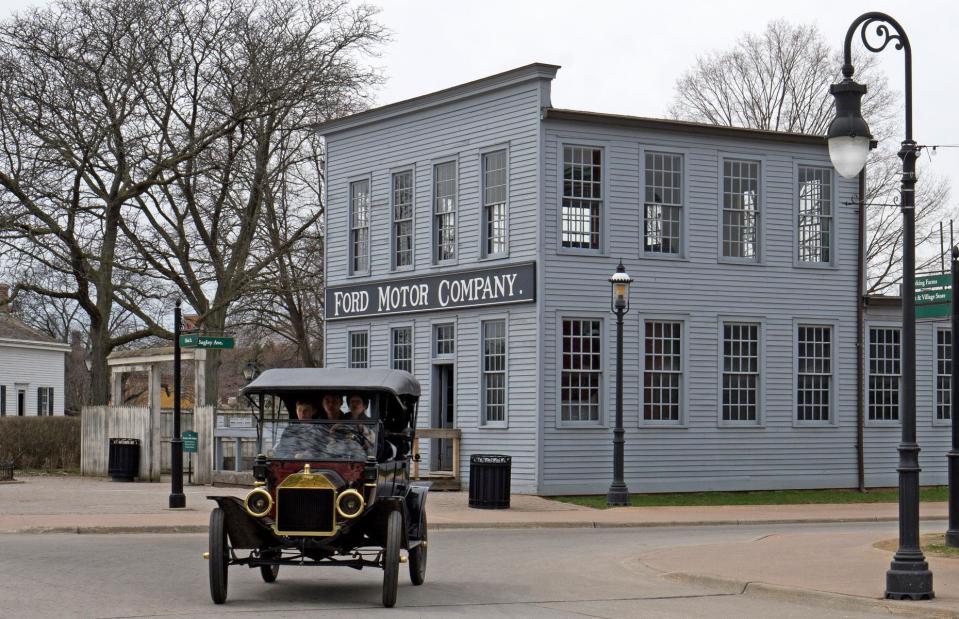
berni0004 / Shutterstock
Greenfield Village is the exterior part of the complex. It opened to the public in 1933. America's first outdoor museum, the attraction features 84 emblematic buildings that tell the story of the country's economic development.
Clearly assured of his place in US history, Henry commissioned a replica of the original 1903 Ford factory for the attraction. Greenfield Village includes a collection of important buildings that played a role in Henry's life and the genesis of Ford, including his birthplace cottage, old schoolhouses and Bagley Avenue workshop, which was recreated using bricks from the Bagley Avenue rowhome.
An extraordinary collection
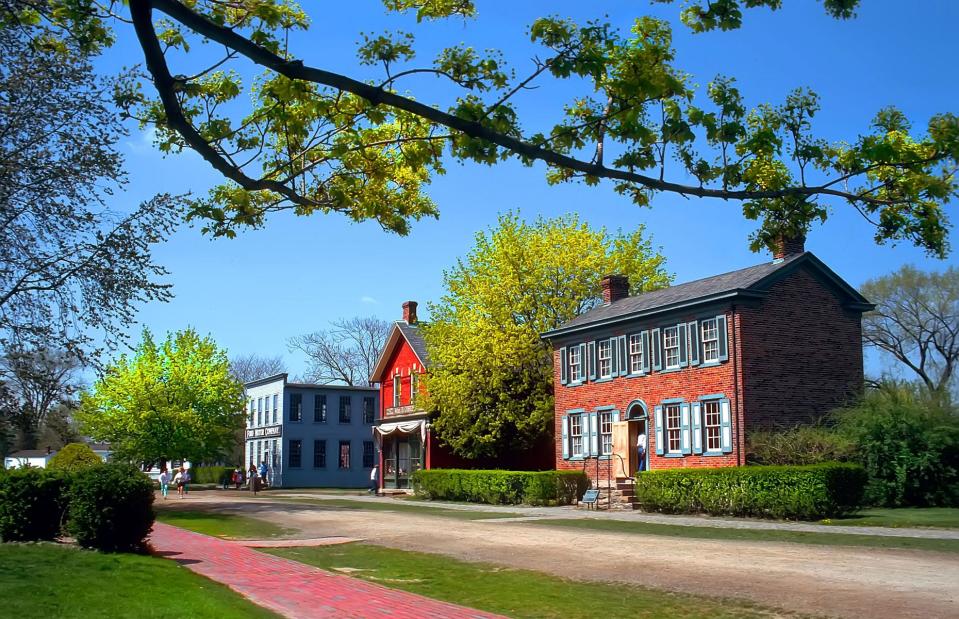
Dennis MacDonald / Shutterstock
The outdoor museum has a fascinating array of historically significant structures. Next to the recreated Ford factory is Mrs D Cohen's millinery shop. Dating from the 1880s, the building is a fine example of a retail store from the period. Along from Mrs Cohen's shop is the 1854 house where Henry J Heinz started his canning business.
Other notable buildings from American history that were either transplanted to the site or recreated there include the nation's oldest windmill built in the mid-1600s, America's first silk mill from 1810, a reproduction of Thomas Edison's Menlo Park laboratory and Wilbur and Orville Wright's bicycle shop.
Greenfield Village in Dearborn, Michigan

Rosemary Behan / Alamy
Despite the focus on American history, Henry found space for several buildings from England. Smitten with the typical Cotswold cottage with its characteristic yellow-brown stone, tall gables and pitch roofs, Henry imported this exquisite example from the village of Chedworth in Gloucestershire. It dates from 1619.
The automaker also imported a Cotswold stable and forge, which was built as long ago as 1600, making it possibly the oldest structure in the complex.
The Ford Plantation in Richmond Hill, Georgia
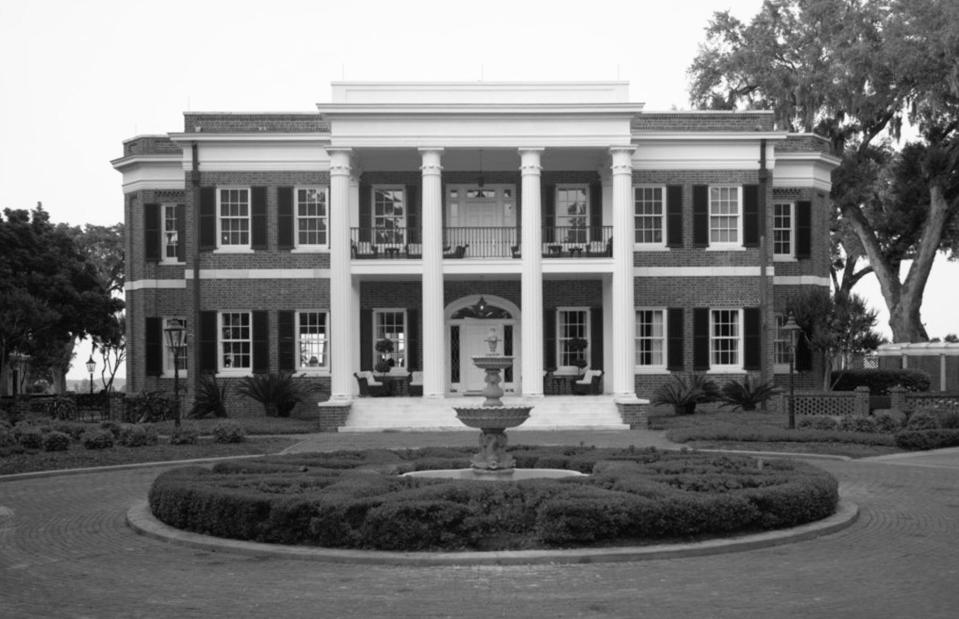
US Library of Congress / Public domain
In 1936, construction began on the Fords' custom plantation mansion. Set on 55 acres (22ha), the glorious 7,000-square-foot (650sqm) Greek Revival beauty was completed a year later at a site on the Ogeechee River picked by Clara. Henry converted an old rice mill into a laboratory and powerhouse and the entire project was completed the following year.
Still, Henry had little to celebrate in 1937. The Great Depression had ushered in tough times for Ford and between 1929 and 1932, the company had to let go of almost half its workforce. Wages were cut and workers were keen to organise. Henry was vehemently anti-union and fought against collective bargaining throughout the 1930s. The company's increasingly oppressive intimidation tactics shocked the American public and damaged Ford's reputation.
A complex character
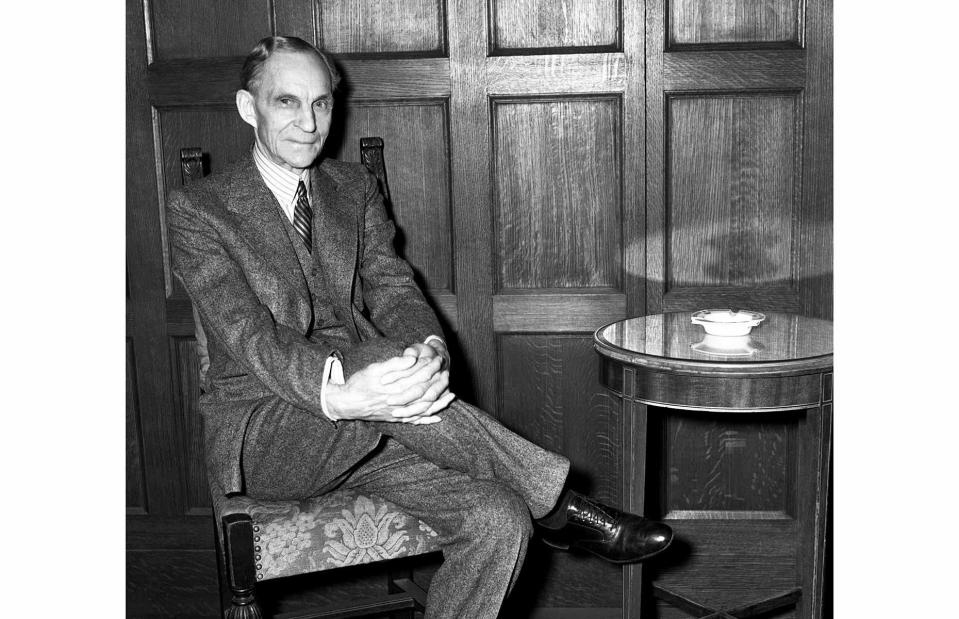
Irving Haberman / IH Images / Getty Images
Henry's legacy has also been tarnished by allegations of antisemitism and racism. According to PBS, the auto tycoon took ownership of local Detroit newspaper The Dearborn Independent between 1919 and 1927, during which time it was used to publish a number of antisemitic articles. Ford's hiring policies were also said to discriminate against Jewish applicants. While Henry was no doubt a man of great innovation, it's important to acknowledge the complexities of his character when we consider the empire he built – and the many homes he collected with its spoils.
Richmond Hill

US Library of Congress / Public domain
One such jewel in Henry's real estate collection, the Fords' new winter bolthole was christened Richmond Hill Plantation, which is curious since the surrounding area is notoriously flat. When asked why he added 'Hill' to the name, Henry wryly responded that "anything not a swamp around here is named a hill." Resplendent in fine Savannah grey brick, the home was fitted with all mod cons, including air conditioning, an elevator and a large resort-style swimming pool.
Investing in the community
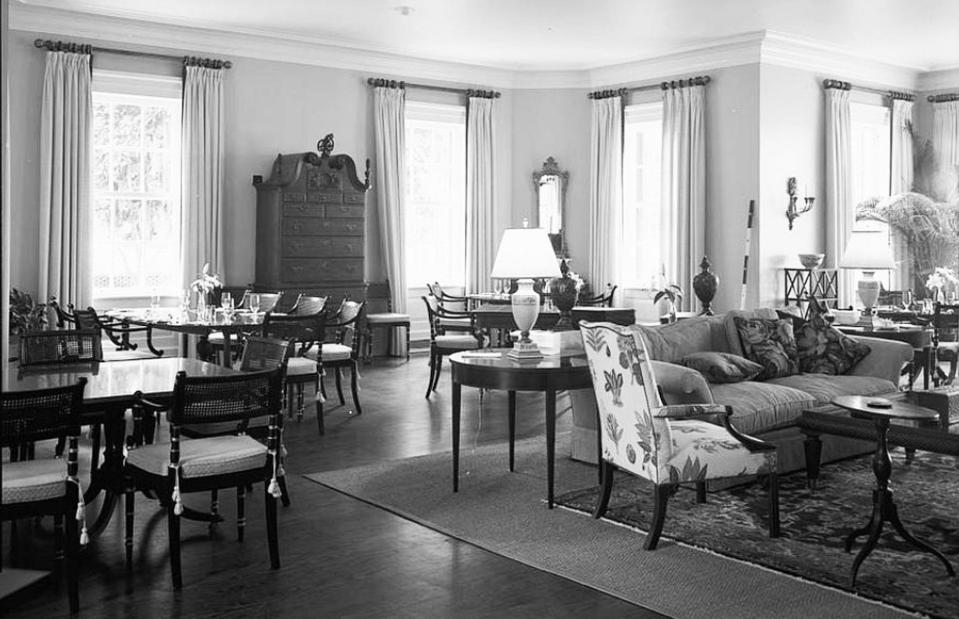
US Library of Congress / Public domain
The Fords lived in sumptuous style in the rambling riverfront mansion. The couple did however give back to the community in a major way. After Henry discovered the impoverished locals could only make money brewing moonshine, he built a sawmill, updated the local infrastructure and provided amenities, from schools to medical facilities.
Henry finally caved into the autoworkers' union's demands in 1941, largely thanks to the advice of his son Edsel, who had been president of the Ford Motor Company since 1919. However, tragedy struck in 1943 when Edsel died of stomach cancer at the age of 49. A grief-stricken Henry stepped back into the leadership role but suffered a series of strokes and in 1945, he passed the baton to his grandson Henry II.
A lasting legacy
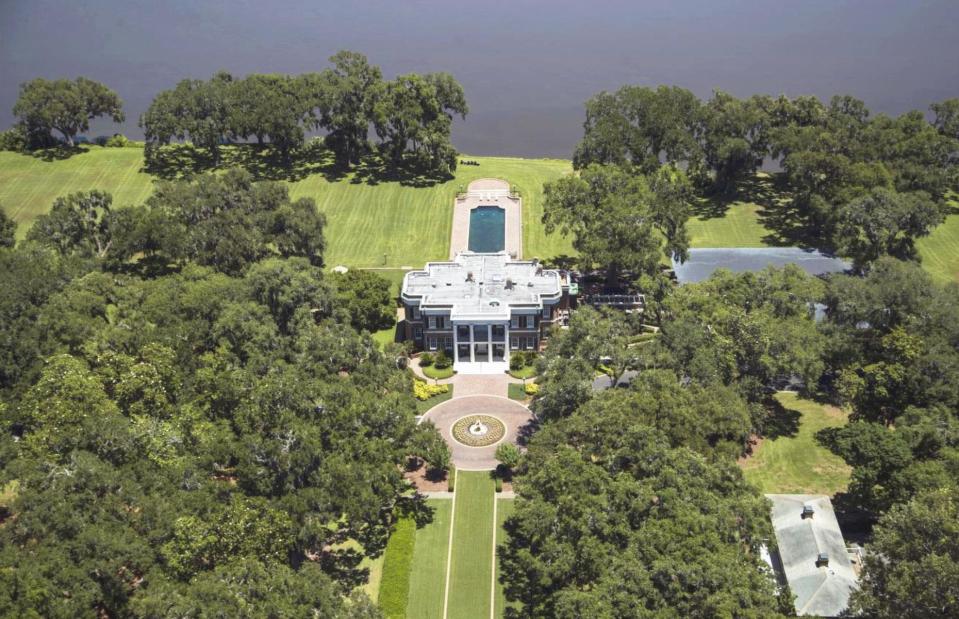
Carol Highsmith / US Library of Congress / Public domain
Henry died in 1947 one of the richest people in the world, leaving a fortune equivalent to around $250 billion (£197bn) in 2024 money. Richmond Hill was sold to the International Paper Company in 1951 and is now part of a private club.
The lion's share of Henry's money went to the Ford Foundation. One of the world's best-endowed foundations, the organisation has contributed billions of dollars over the years to good causes, funding everything from higher education establishments and civil rights groups to HIV charities.
While Henry Ford's legacy is somewhat complex, the auto pioneer's incredible achievements are undeniable and his impact far-reaching.


